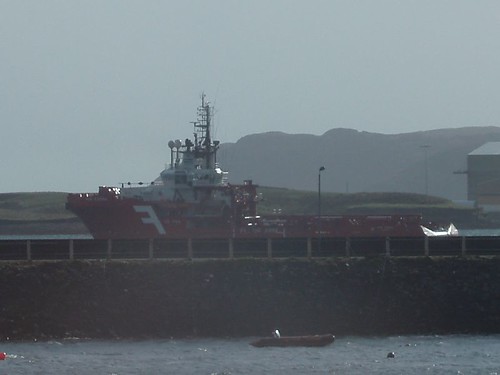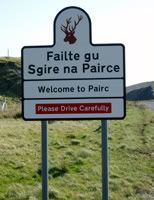The controversy surrounding the three windfarms on Lewis took on a new slant on Wednesday. Apart from having some 300 turbines on the island (181 in North Lewis, 53 in Eishken and 65 in Pairc], standing 450 to 500 feet tall, there is also the associated infrastructure. I am talking powerlines, substations and the line to the mainland, referred to as the interconnector.
Having generated all that power, it obviously has to go to the National Grid, which is envisaged to be via the interconnector (a 60 mile long subsea cable) to Little Loch Broom, south of Ullapool. From there, a line will be built to Beauly, west of Inverness. The existing powerline from Beauly to Denny (near Stirling) is due to be upgraded.
Restricting this post to the island side of this infrastructure, the residents of Gravir (10 miles east of Balallan) were unpleasantly surprised to learn that their tiny township had been selected as the site for the interconnector from Lewis to the mainland. Gravir sits at the head of Loch Odhairn, surrounded by moorland, linked by road to Lemreway in the south, Marvig in the northeast and Balallan (on the main A859 Stornoway to Tarbert road) in the west. I happen to know the area very well indeed.
In order to house the interconnector, powerlines will be marching across the moors from Stornoway to Grimshader, Crossbost / Leurbost and Keose, then under Loch Erisort to Garyvard and over the moors to Gravir. A huge substation will be built near the village, the size of 20 houses. Pylons will also feed in from the Eishken windfarm, as well as from the Pairc turbines on the adjacent estate. Basically, Glen Odhairn stands to be industrialised, where at present it is a wilderness, backing on to the Eishken estate.
This
map (opens in separate window) shows my personal interpretation of the information at hand. I do NOT make any claims to accuracy.
Local residents have expressed outrage at the prospect of having huge pylons and infrastructure right outside their front doors. Concerns have also been aired about the possible harmful effects of high-voltage powerlines; some research suggests that the electromagnetic fields surrounding these transmission lines is a contributary factor in the development of childhood leukaemia.
It was stressed by developers SSE that this is only a voluntary exercise, with more formal sessions to follow later. A planning application is yet to be submitted, and construction is a long way off. A public exhibition is due to be held at Stornoway, Kershader and Ullapool by SSE in mid-April.
I have so far refrained from passing comment on the Pairc windfarm, bearing in mind the efforts to buy out the estate, but I sometimes wonder if those in favour of these schemes have properly visualised the impact a windfarm with associated infrastructure has.












